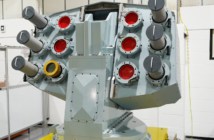By Matt Thompson
The 2024 year has started off with a bang. AOC Director of Advocacy and Outreach, Ken Miller, and I had the opportunity to visit Davis Monthan Air Force Base, in Tucson, Arizona, and meet with several members of the Compass Call community. As the Senior Analyst for the Association of Old Crows, my visit to Davis-Monthan Air Force Base was a deeply informative and engaging experience, especially in understanding the ongoing transition to the EA-37B underway in the 55th Electronic Combat Group (ECG), who really rolled the red carpet out for us. Special Thanks to them.
Our group was greeted by Lt. Col. Jesse Palchick, 55th ECG Deputy Group Commander, who provided an overview of the Compass Call “campus” at Davis Monthan, and the 55th ECG’s mission. We had the opportunity to meet with nearly all the 55th ECG tenet commands including the 41st, 42nd, 43rd and 755th Operations Support and Maintenance Squadrons.
The real purpose of the trip was to get a handle on the current state of affairs in the EC Community. We had the privilege of attending briefings by several team members. Capt James Wihlborg gave an excellent overview of where the current Compass Call force is as of January 2024, shedding light on the technical aspects and operational use of the EC-130H. We also discussed some of the maintenance and training challenges of the aging airframe of the EC-130H fleet and the large number of aircrew who still need to fly and stay current. We also discussed some of the current upgrades and systems that will transition and lead the way in the new EA-37B.
In a separate session, Lt. Col. Gregory Harris discussed the upcoming transition to the EA-37B, including when the first aircraft is scheduled to be present on site. His briefing was programmatically based discussing airframe deliveries, numbers of planes, planes in tests and spiral upgrades as well as planned IOC dates. Looking at the program and dates reminded me of when I was in the Navy Transitioning the EA-6B Prowler to the EA-18G Growler. Balancing the sundown and stand up of aircraft and aircrew is a challenging and daunting task. I could see that present in the Compass Call Transition plan as well. One of the many challenges that comes with being a High Demand Low Density platform is the push to finish the transition yesterday and IOC to be tomorrow. There are still many hurdles in front of the program as they work through DT/OT, vendor deliveries, not to mention writing all the required publications and standing up the formal training unit (FTU). The arrival of the first aircraft this Spring is an important milestone, but by no means does it represent completion of work. Quite the opposite, but it is clear the Compass Call team is ready for any challenges.
Interviews with Lt. Col. Palchick and 1st Lt. Colin Schulz provided deeper insights into the human aspect of Compass Call as well. Their stories and experiences brought to life the dedication and pride that the ECG community holds for their mission. They also sat down with Ken Miller to produce a podcast, which will air in February, so watch for that upcoming episode on the horizon.
Finally, we had the opportunity to walk through an EC-130H, always a great opportunity. To hear the dedication and appreciation of our warfighters is something no briefing can convey. It was very easy to see the pride in the current platform while feeling the excitement about the future.
Although the EA-37B was not physically present yet, the discussions and briefings about its anticipated role painted a clear picture of the future of electronic warfare. The platform will be great, but more importantly it was obvious we have the right team ready to meet its arrival.
It is easy sometimes to see the future potential and overlook the challenges and needs moving forward. In the coming months, as we continue to monitor developments around the arrival of the EA-37B, here are just a few questions that we need to think about as we advocate for EW across the services and around the world.
Questions We Need to Ask
First, can the Air Force maintain its aggressive timeline? Transitions of platforms like this usually are very aggressive. There is very little room for inevitable vendor delays. The program relies on many third parties to get the US Air Force where they want to be with the new Compass Call. The timeline does very little to allow for vendor delays. There have already been some delays and it is important to assist the US Air Force EA-37B Program Office, a very small team of about five, to work with the multiple vendors and ensure they meet their requirements on time. Lt. Col. Harris made a tongue in joke about his job being a house of cards, but I can recall transitioning to the EA-18G that any one key item can bring the whole timeline down.
Second, can the USAF adapt to pressures to modify or update program requirements? Another challenge of bringing a program like this online is that it takes several years, but the outside technological world continues to progress rapidly. There are often pressures to add updated requirements to match what is occurring outside the program. This is a dangerous and slippery slope that could endanger the delivery timeline as well. It is important to accept the requirements as they are and press forward, accepting the risk that the planned spiral upgrade program will be necessary to update the platform once it is online.
Lastly, can we maintain our focus on warfighter training? The people piece is always a delicate balance. The EC-130H sundown timeline is in motion, and the number of airframes is being reduced by one or two every few months, while still supporting real world operations and managing training and currency at home. The maintenance squadron struggles to get parts and exhausts man hours to keep the aging platform flying. Additionally, with the new Compass Call the maintenance department is transitioning to all contract maintenance. This carries some inherent risk also. The squadrons are still full of aircrew that need to fly and stay current. Some of these aircrews are tapped to be the cadre for the EA-37B FTU. They will be getting trained and then train aircrew literally right behind them as the first squadron transitions. Their sister squadron will be handling all the operations globally while the teammates transition. These are significant risks for a platform as important as Compass Call.
These are just some of the many items we need to track and ensure we do what we can to help the program stay on time. Keep an eye for future updates and items we need to assist with to “keep’em flying!”
In closing, I would be remiss if I didn’t give a special Thanks to 1st Lt. Trey Miller and A1C Megan Kabus for spending the day with us and showing us around. Looking forward to our next visit in late March.






